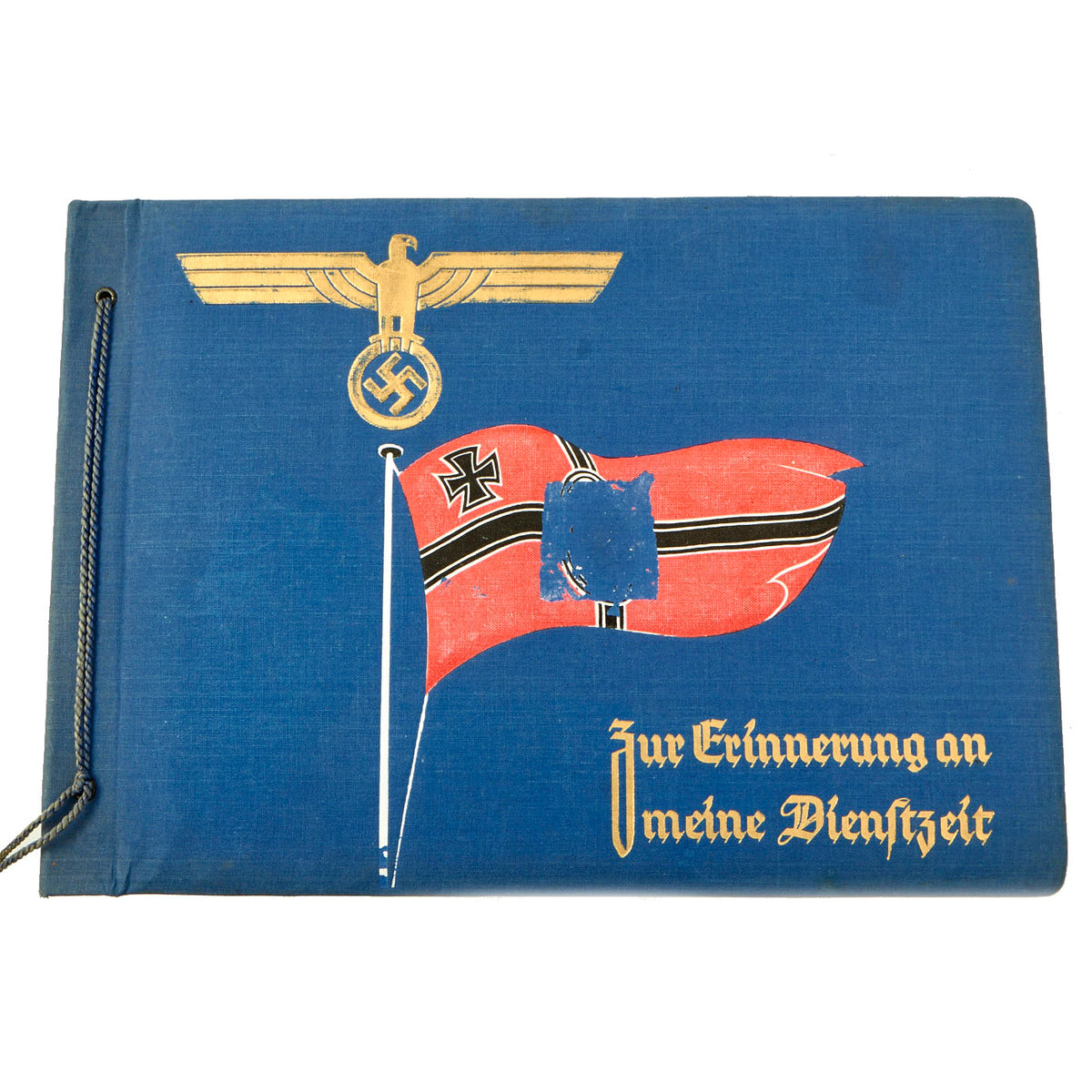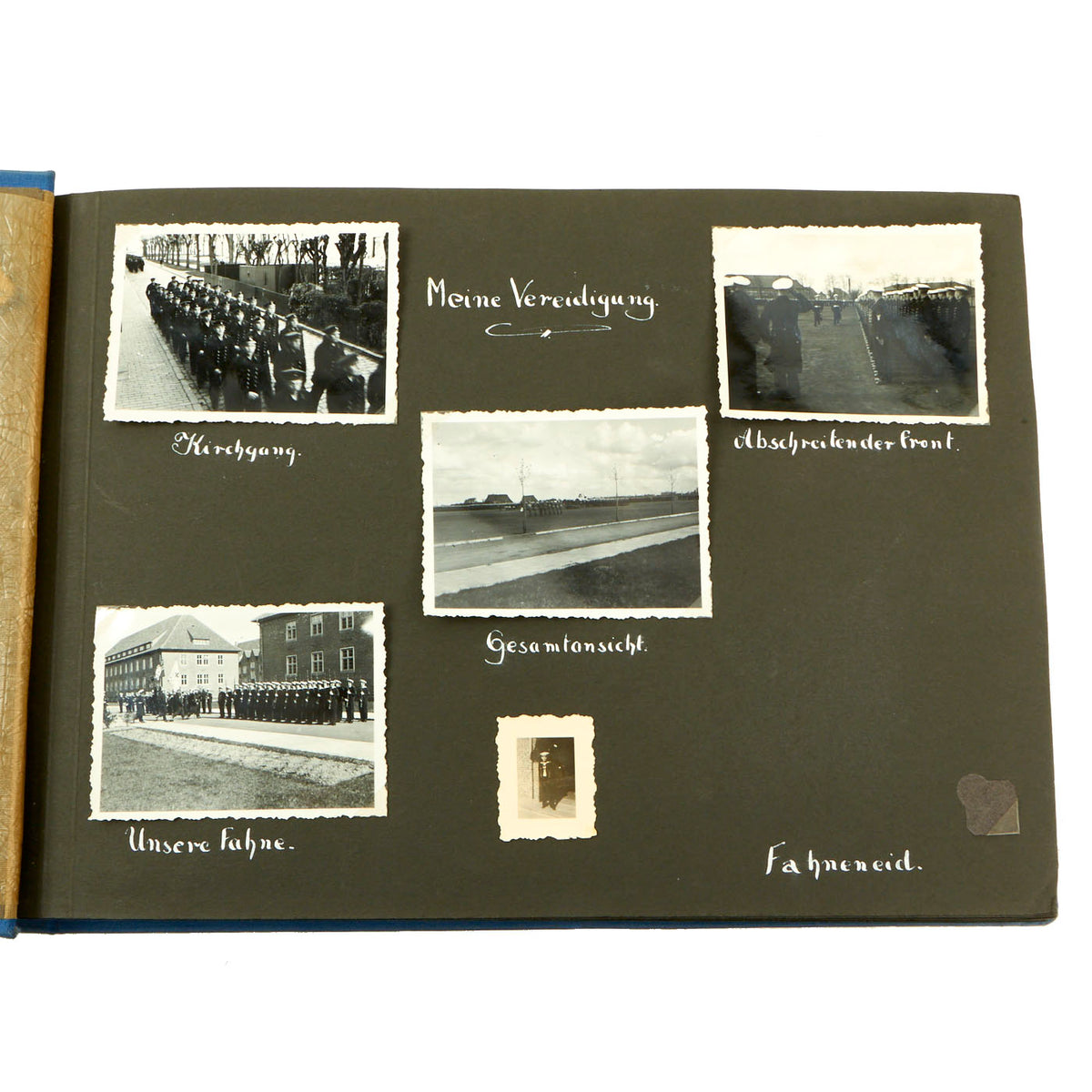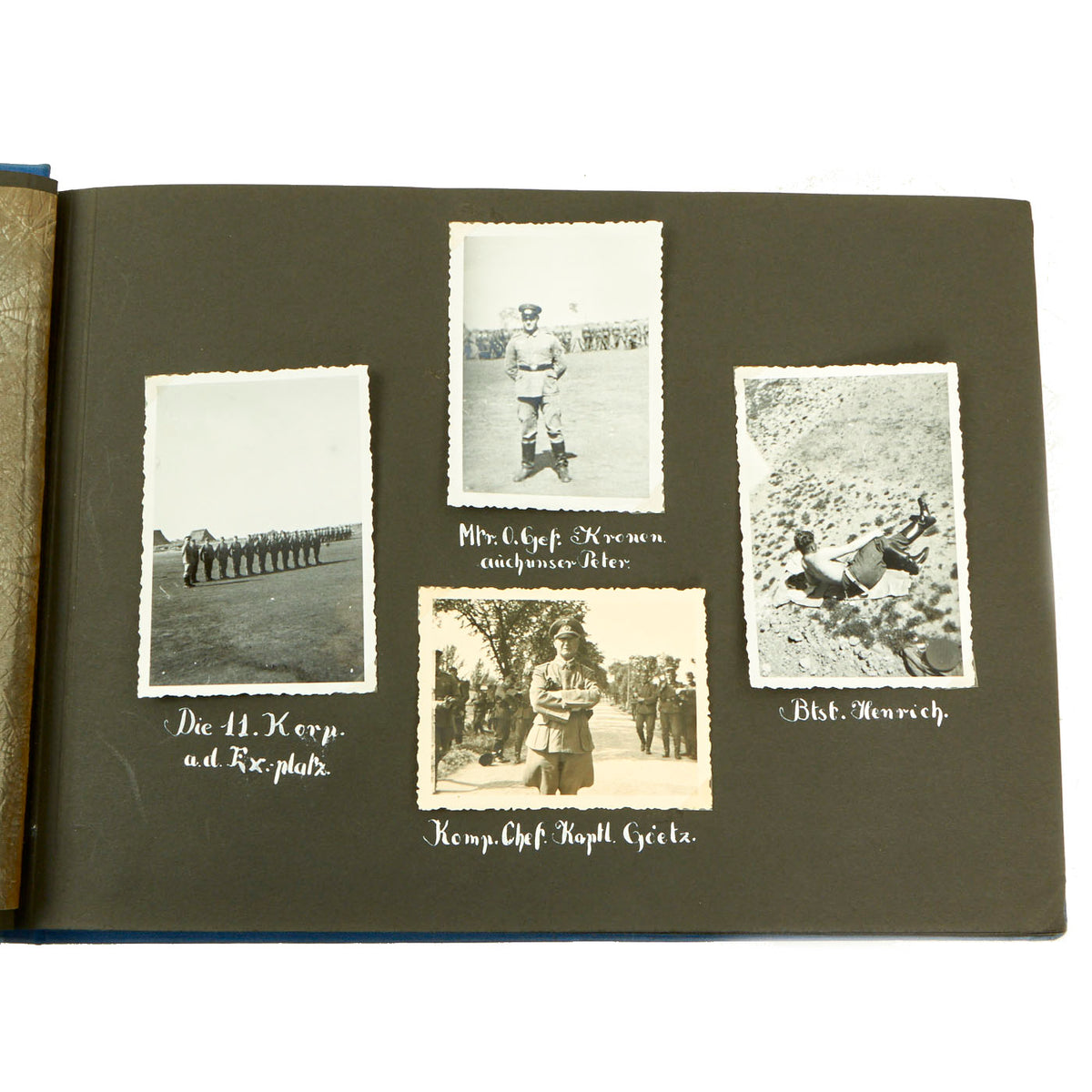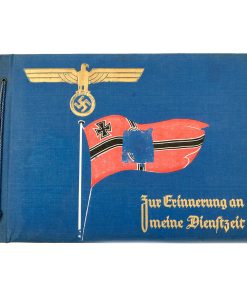Original German WWII Kriegsmarine Naval Service Personal Photo Album from 14. Schiffsstammabteilung – 194 Photos Original Items
$ 495,00 $ 148,50
Original Item: One-of-a-kind-set. Here we have a wonderful personal photo album with some professional shots but mostly personal snapshots, some of which have military Naval vessels, artillery, soldiers and officers. All photos are held in place with period corner tabs. Front cover features a gold embossed Wehrmachtadler eagle in the upper left, over a Kriegsmarine Reichskriegsflagge (Battle Flag) in the center, which has been “Sanitized” by removal of the swas. The lower right is embossed with Zur Erinnerungen an Meine Dienstzeit (In Memory of My Service). The album measures approximately 13″ x 9″ x 1″.
On the inside of the front cover a Kriegsmarine cap tally made from gold bullion embroidered rayon or silk has been glued on, and reads: 14. Schiffsstammabteilung. The Schiffs–Stamm-Abteilung (Ship’s Administration Department) groups were liaisons for port commands and also served as the ultimate authority for personnel in transit or stationed in shore naval garrisons. There is actually some records of this particular unit available online: 14. Schiffsstammabteilung at Axishistory.
A total of 194 photographs fill the 24 pages of this album, making it a treasure-trove of images taken from the viewpoint of a young, patriotic German sailor. The pages are all well captioned, and are separated by “spiderweb” pattern “onion skin” separators. The photos show Kriegsmarine uniforms (both white and field gray), marching scenes, ceremonies, and other events, many with identified locations. There are also some identified officers, photos taken in the port of KIEL including ships in the harbor, and even an 8.8cm Flak gun firing at night. There are also some studio portraits, and even photos of a serviceman receiving his Iron Cross 2nd class.
Historical records like this album have become priceless time capsules that provide an incomparable level of insight into the individual experience of the Second World War, now that almost eighty years have passed.
The Kriegsmarine was the navy of NSDAP Germany from 1935 to 1945. It superseded the Imperial German Navy of the German Empire (1871–1918) and the inter-war Reichsmarine (1919–1935) of the Weimar Republic. The Kriegsmarine was one of three official branches, along with the Heer and the Luftwaffe, of the Wehrmacht, the German armed forces from 1935 to 1945.
In violation of the Treaty of Versailles, the Kriegsmarine grew rapidly during German naval rearmament in the 1930s. The 1919 treaty had limited the size of the German navy and prohibited the building of submarines.
Kriegsmarine ships were deployed to the waters around Spain during the Spanish Civil War (1936–1939) under the guise of enforcing non-intervention, but in reality supported the Nationalists against the Spanish Republicans.
In January 1939, Plan Z, a massive ship-building program, was ordered, calling for surface naval parity with the British Royal Navy by 1944. When World War II broke out in September 1939, Plan Z was shelved in favor of a crash building program for submarines (U-boats) instead of capital surface warships, and land and air forces were given priority of strategic resources.
The Commander-in-Chief of the Kriegsmarine (as for all branches of armed forces during the period of absolute NSDAP power) was AH, who exercised his authority through the Oberkommando der Marine (“High Command of the Navy”).
The Kriegsmarine’s most significant ships were the U-boats, most of which were constructed after Plan Z was abandoned at the beginning of World War II. Wolfpacks were rapidly assembled groups of submarines which attacked British convoys during the first half of the Battle of the Atlantic but this tactic was largely abandoned by May 1943 when U-boat losses mounted. Along with the U-boats, surface commerce raiders (including auxiliary cruisers) were used to disrupt Allied shipping in the early years of the war, the most famous of these being the heavy cruisers Admiral Graf Spee and Admiral Scheer and the battleship Bismarck. However, the adoption of convoy escorts, especially in the Atlantic, greatly reduced the effectiveness of surface commerce raiders against convoys.
Following the end of World War II in 1945, the Kriegsmarine’s remaining ships were divided up among the Allied powers and were used for various purposes including minesweeping. Some were loaded with superfluous chemical weapons and scuttled.
Fast Shipping with Professional Packaging
Thanks to our longstanding association with UPS FedEx DHL, and other major international carriers, we are able to provide a range of shipping options. Our warehouse staff is expertly trained and will wrap your products according to our exact and precise specifications. Prior to shipping, your goods will be thoroughly examined and securely secured. We ship to thousands clients each day across multiple countries. This shows how we're dedicated to be the largest retailer on the internet. Warehouses and distribution centres can be located throughout Europe as well as the USA.
Note: Orders with more than one item will be assigned a processing date depending on the item.
Before shipping before shipping, we'll conduct a thorough inspection of the items you have ordered. Today, the majority of orders will be delivered within 48 hours. The delivery time will be between 3-7 days.
Returns
The stock is dynamic and we cannot completely manage it because multiple stakeholders are involved, including our factory and warehouse. So the actual stock may alter at any time. It's possible that you may not receive your order once the order has been made.
Our policy is valid for a period of 30 days. If you don't receive the product within 30 days, we are not able to issue a refund or an exchange.
You can only return an item if it is unused and in the same state as the day you received it. You must have the item in its original packaging.
Related products
Uncategorized
Uncategorized
Uncategorized
Uncategorized
Uncategorized
Band of Brothers ORIGINAL GERMAN WWII Le. F.H. 18 10.5cm ARTILLERY PIECE Original Items
Uncategorized
Uncategorized
Uncategorized
Uncategorized
Uncategorized
Australian WWII Owen MK1 Machine Carbine SMG Custom Fabricated Replica with Sling Original Items
Uncategorized
Uncategorized
Uncategorized
Armored Burgonet Helmet & Polearm from Scottish Castle Leith Hall Circa 1700 Original Items
Uncategorized
Uncategorized













































































